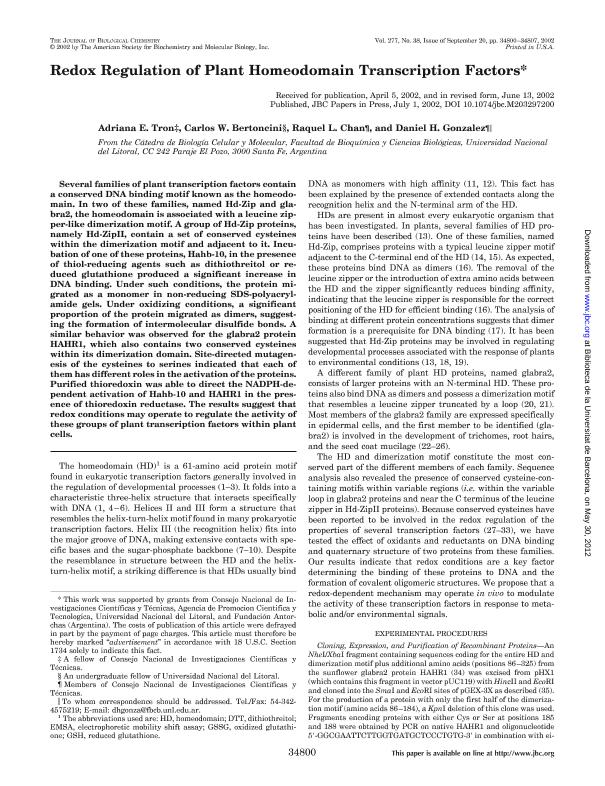Artículo
Redox regulation of plant homeodomain transcription factors
Fecha de publicación:
09/2002
Editorial:
American Society for Biochemistry and Molecular Biology
Revista:
Journal of Biological Chemistry (online)
ISSN:
0021-9258
Idioma:
Inglés
Tipo de recurso:
Artículo publicado
Clasificación temática:
Resumen
Several families of plant transcription factors contain a conserved DNA binding motif known as the homeodomain. In two of these families, named Hd-Zip and glabra2, the homeodomain is associated with a leucine zipper-like dimerization motif. A group of Hd-Zip proteins, namely Hd-ZipII, contain a set of conserved cysteines within the dimerization motif and adjacent to it. Incubation of one of these proteins, Hahb-10, in the presence of thiol-reducing agents such as dithiothreitol or reduced glutathione produced a significant increase in DNA binding. Under such conditions, the protein migrated as a monomer in non-reducing SDS-polyacrylamide gels. Under oxidizing conditions, a significant proportion of the protein migrated as dimers, suggesting the formation of intermolecular disulfide bonds. A similar behavior was observed for the glabra2 protein HAHR1, which also contains two conserved cysteines within its dimerization domain. Site-directed mutagenesis of the cysteines to serines indicated that each of them has different roles in the activation of the proteins. Purified thioredoxin was able to direct the NADPH-dependent activation of Hahb-10 and HAHR1 in the presence of thioredoxin reductase. The results suggest that redox conditions may operate to regulate the activity of these groups of plant transcription factors within plant cells.
Archivos asociados
Licencia
Identificadores
Colecciones
Articulos(CCT - SANTA FE)
Articulos de CTRO.CIENTIFICO TECNOL.CONICET - SANTA FE
Articulos de CTRO.CIENTIFICO TECNOL.CONICET - SANTA FE
Articulos(IAL)
Articulos de INSTITUTO DE AGROBIOTECNOLOGIA DEL LITORAL
Articulos de INSTITUTO DE AGROBIOTECNOLOGIA DEL LITORAL
Citación
Tron, Adriana E.; Bertoncini, Carlos Walter; Chan, Raquel Lia; Gonzalez, Daniel Hector; Redox regulation of plant homeodomain transcription factors; American Society for Biochemistry and Molecular Biology; Journal of Biological Chemistry (online); 277; 38; 9-2002; 34800-34807
Compartir
Altmétricas




